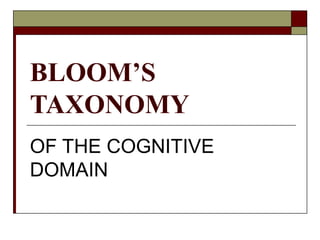
Blooms
- 2. BLOOM’S TAXONOMY Competence Skills Demonstrated Knowledge The recall of specific information Comprehension Understanding of what was read Application Converting abstract content to concrete situations Analysis Comparison and contrast of the content to personal experiences Synthesis Organization of thoughts, ideas, and information from the content Evaluation Judgment and evaluation of characters, actions, outcomes, etc., for personal reflection and understanding
- 3. KNOWLEDGE Memorization Observation and recall of information Knowledge of dates, events, places Knowledge of major ideas Mastery of subject matter
- 4. KNOWLEDGE Memorization Arrange Define Describe Duplicate Identify Label List Memorize Name Order Quote Recall Recognize Relate Repeat Reproduce
- 5. COMPREHENSION Understanding Understand information Grasp meaning Translate knowledge into new content Interpret facts, compare, contrast Order, group, infer causes Predict consequences
- 6. COMPREHENSION Understanding Classify Describe Discuss Explain Express Identify Indicate Locate Recognize Report Restate Review Select Translate
- 7. APPLICATION Using Use information Use methods, concepts, theories in new situations Solve problems using required skills or knowledge
- 8. APPLICATION Using Apply Choose Demonstrate Dramatize Employ Illustrate Interpret Operate Practice Schedule Sketch Solve Use Write
- 9. ANALYSIS Taking apart Recognition of patterns Organization of parts Discovery of hidden meanings Identification of components
- 10. ANALYSIS Taking apart Analyze Appraise Calculate Categorize Compare Contrast Criticize Differentiate Discriminate Distinguish Examine Experiment Question Test
- 11. SYNTHESIS Putting together Use old ideas to create new ones Generalize from given facts Relate knowledge from several areas Predict, draw conclusions
- 12. SYNTHESIS Putting together Arrange Assemble Collect Compose Construct Create Design Develop Formulate Manage Organize Plan Prepare Propose Set up Write
- 13. EVALUATION Judging Compare and discriminate between ideas Assess value of theories, presentations Make choices based on reasoned argument Verify value of evidence Recognize subjectivity
- 14. EVALUATION Judging Appraise Argue Assess Attach Choose Compare Defend Estimate Judge Predict Rate Select Support Value Evaluate Explain
- 15. REFERENCES Bloom, B., Englehart M., Furst, E., Hill, W.,& Krathwohl, D. (1956). Taxonomy of educational objectives: The classification of educational goals. Handbook I: Cognitive Domain. New York: Longmans Green.
- 16. Web resources http://www.che.wsu.edu/~millerre/bloom.html http://www.coun.uvic.ca/learn/program/hndouts/blo om.html http://www.kent.wednet.edu/KSD/MA/resources/blo oms/teachers_blooms.html http://www.tecweb.org/eddevel/blooms.html http://www.valdosta.peachnet.edu/~whuitt/psy702/c ogsys/critthnk.html
- 17. BLOOM’S TAXONOMY applied to GOLDILOCKS AND THE THREE BEARS
- 18. KNOWLEDGE the recall of specific information Who was Goldilocks? Where did she live? With whom? What did she do in the forest?
- 19. COMPREHENSION an understanding of what was read This story is about ___________ (topic). This story tells us _________(main idea). What did Goldilocks look like?
- 20. APPLICATION the converting of abstract content to concrete situations How were the bears like real people? Why did Goldilocks go into the little house? Draw a picture of what the bears’ house looked like. Draw a map showing Goldilocks’ house, the path in the forest, the bears’ house, etc.
- 21. ANALYSIS the comparison and contrast of the content to personal experience How did each bear react to what Goldilocks did? How would you react? Compare Goldilocks to any of your friends. Do you know any animals (pets) that act human?
- 22. SYNTHESIS the organization of thoughts, ideas, and information from the content List the events of the story in sequence. Do you know any other stories about little girls or boys who escaped from danger? Make a diorama of the bears’ house and the forest. Make a puppet out of one of the characters. Using the puppet, act out his/her part of the story.
- 23. EVALUATION the judgment and evaluation of characters, actions, outcomes, etc., for personal reflection and understanding Why were the bears angry with Goldilocks? Do you think Goldilocks was happy to get home? Explain your answer. Do you think she learned anything by going into the bears’ house? Explain your answer. Would you have gone into the bears’ house? Why or why not?
- 24. EVALUATION CON’T. Do parents have more experience and background than their children? Give an example from your own history. Do you think this really happened to Goldilocks? Why or why not? Why would a grown-up write this story for children to read? Why has the story of Goldilocks been told to children for many, many years?
